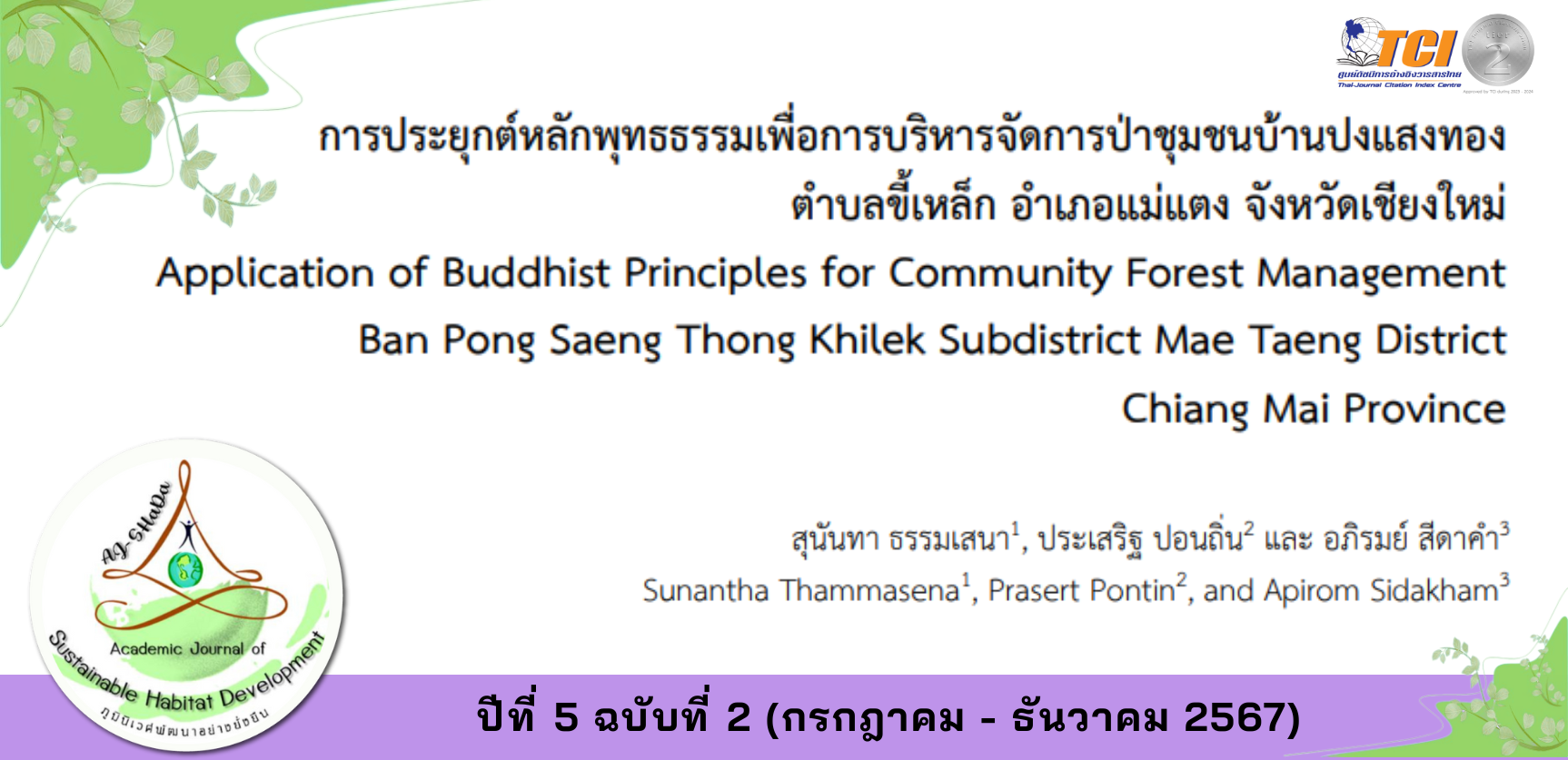Application of Buddhist Principles for Community Forest Management Ban Pong Saeng Thong Khilek Subdistrict Mae Taeng District Chiang Mai Province
Main Article Content
Abstract
This research aims to: 1) study the management of community forests, 2) examine the application of Buddhist principles in community forest management, and 3) identify approaches for applying Buddhist principles in the management of Pong Saeng Thong Community Forest, located in Khilek Subdistrict, Mae Taeng District, Chiang Mai Province. This research utilizes a participatory action research approach. Key informants include community leaders, representatives from local organizations/agencies, and residents of the area, totaling 17 individuals. Data collection methods are diverse, including document analysis, field data, area surveys, observations, and interviews. The data were then analyzed and synthesized based on the research themes and presented in a descriptive format.
The study results indicate that Pong Saeng Thong, located in Khilek Subdistrict, Mae Taeng District, Chiang Mai Province, encompasses a community forest area of 1,000 rai. This forest is a potential natural food source, rich and available year-round, and serves other uses for the community members. A community forest committee has been established to set clear objectives and goals for the conservation and restoration of the community forest. The management of the community forest emphasizes a participatory mechanism involving all sectors and incorporates the application of the seven principles of Sappaya in the conservation and restoration process. The approach to applying Buddhist principles in community forest management promotes a way of life that encourages mutual reliance and support. It consists of seven factors: suitable dwelling, suitable transportation, suitable conversation, suitable people, suitable food, suitable climate, and suitable activities.
Article Details

This work is licensed under a Creative Commons Attribution-NonCommercial-NoDerivatives 4.0 International License.
References
กระทรวงทรัพยากรธรรมชาติและสิ่งแวดล้อม. (2561). แผนจัดการมลพิษ พ.ศ. 2555–2559. กรุงเทพฯ: กองแผนงานและประเมินผลกรมควบคุมมลพิษ.
โกมล แพรกทอง. (2549). ความรู้เบื้องต้นเกี่ยวกับป่าไม้ชุมชน. นนทบุรี: มหาวิทยาลัยสุโขทัยธรรมาธิราช.
คณิต ธนูธรรมเจริญ และศิรินทิพย์ ผาเจริญ. (2566). แผนชุมชน : การใช้ประโยชน์ที่ดินทำกินชุมชนตำบลภูฟ้า อำเภอบ่อเกลือ จังหวัดน่าน. วารสารสังคมศาสตร์และศาสตร์รวมสมัย, 4(1), 93-108.
ธนพร เรือนคำ. (2565). วัดเชียงมั่น: การพัฒนาตามหลักสัปปายะเพื่อส่งเสริมการท่องเที่ยวเชิงพุทธศาสนาในจังหวัดเชียงใหม่. (วิทยานิพนธ์ศาสนศาสตรดุษฎีบัณฑิต). มหาวิทยาลัยมหามกุฏราชวิทยาลัย วิทยาเขตล้านนา, เชียงใหม่.
พระธรรมปิฎก (ป.อ.ปยุตฺโต). (2537). ความสำคัญของพระพุทธศาสนาในฐานะศาสนาประจำชาติ. กรุงเทพฯ: บริษัทสหธรรม จํากัด.
พระภัทรชัยญกรณ์ อูดสวย. (2564). รูปแบบการบริหารการจัดการโรงเรียนสีเขียวตามหลักสัปปายะ 7 แบบมีส่วนร่วม. (วิทยานิพนธ์พุทธศาสตรมหาบัณฑิต). มหาวิทยาลัยมหาจุฬาลงกรณราชวิทยาลัย, พระนครศรีอยุธยา.
วินิจ ผาเจริญ และชาญชัย ฤทธิร่วม. (2565). การมีส่วนร่วมของชาวบ้านในการจัดการป่าชุมชน กรณีศึกษาบ้านตลาดขี้เหล็ก ตำบลแม่โป่ง อำเภอดอยสะเก็ดจังหวัดเชียงใหม่. วารสารสันติสุขปริทรรศน์, 3(1), 47-58.
วิษณุ ทรายแก้ว, จตุพร ชูจันทร์ และภมรรัตน์ สุธรรม. (2560). พัฒนาการมีส่วนร่วมในการบริหารจัดการป่าชุมชนที่ยั่งยืนของประชาชนบ้านยางโพรง ตำบลปากหมาก อำเภอไชยา จังหวัดสุราษฎร์ธานี. วารสารราชภัฎสุราษฏร์ธานี, 4(2), 273-290.
สรรเพชร เพียรจัด. (2565). การพัฒนาสื่อเพื่อการอนุรักษ์และฟื้นฟูป่าชุมชนเขาอังคารบนฐานการมีส่วนร่วมของเยาวชน. (วิทยานิพนธ์ศิลปศาสตรมหาบัณฑิต). มหาวิทยาลัยราชภัฏบุรีรัมย์, บุรีรัมย์.
สำนักงานคณะกรรมการพัฒนาการเศรษฐกิจและสังคมแห่งชาติ. (2562). ยุทธศาสตร์ชาติระยะ 20 ปี (พ.ศ. 2561-2580). พิมพ์ครั้งที่ 2. กรุงเทพฯ: สำนักงานเลขานุการของคณะกรรมการยุทธศาสตร์ชาติ สำนักงานคณะกรรมการพัฒนาการเศรษฐกิจและสังคมแห่งชาติ.

